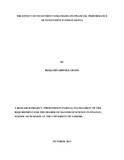| dc.description.abstract | Investment strategy is so crucial for any investment funds manager as it sets of rules, behaviors
or procedures, designed to guide an investor's selection of an investment portfolio. Usually the
strategy will be designed around the investor's risk-return tradeoff: some investors will prefer to
maximize expected returns by investing in risky assets, others will prefer to minimize risk, but
most will select a strategy somewhere in between. Investment strategies are adopted at
organizational, industry and market level and serve as a guide for entering and selecting
investment portfolios.
The objective of this study was to identify investment strategies adopted by investment funds in
Kenya and the effect of the strategies on financial performance of the funds. The population of
study was all investment funds in Kenya and census was carried out on the nineteen investment
funds since they are not many as given by Capital Market Authority Cap. 485A as of 2013.
Primary data was collected through personal interview by use of interview guide to a total of ten
investment managers who turned out to give a positive response. Secondary data was also
collected from respective investment funds financial reports for the year 2012.Desrcriptive
analysis which aims at finding out type of investment strategy was used and classified them
either active investment strategy or passive investment strategy.
The study concludes that investment funds in Kenya takes an active investment strategy and
found out to be integrated into operation investment funds in Kenya; financial performance is of
positive influence to investment funds performance and greatly so is liquidity which probably
means the investment firms utilize liquid assets to make quick investment which translates to
good returns. From inferential statistics, a positive relationship is established between ROA and
the Predictor variables which are investment strategy, Leverage, Liquidity, age and size. Chisquare
test results show that companies with high liquidity can be said to be better performing as
compared to those without or with lower liquidity
those frequently cited for their contributory role. While certain factors appear to recur, there is no
obvious combination of defining characteristics for financial performance that predicts negative
outcomes. Credit control and capability initiatives can help to mitigate potential negative
outcomes of rapid financial loss and should be part of a more comprehensive strategy for
responsible finance among the investment institutions, which includes customer satisfaction,
effective loan recovery mechanisms and financial innovation. Financial capability efforts may
also be able to contribute to the adoption of new products and services as well as sustained
positive behaviors, such as loan repayment, committing to investing, etc. But to be successful at
these tasks, investment literacy and capability programs need to be incorporated in investment
sector’s innovation strategie | |

